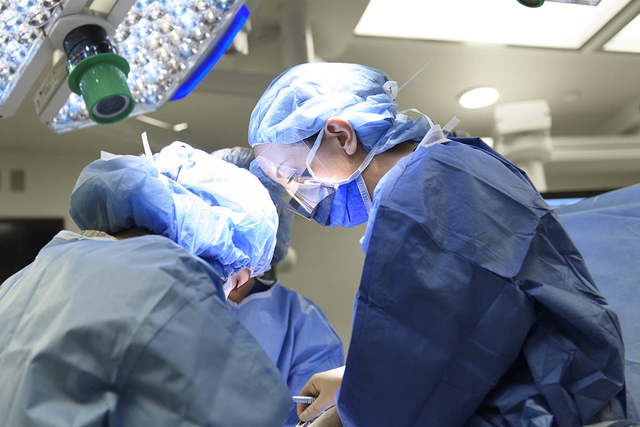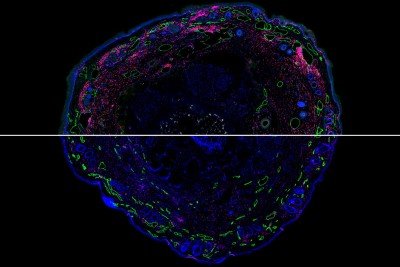
Andrea Barrio (right) and fellow Shirin Muhsen focus on surgery for breast cancer.
Cancer-related lymphedema is one of the most challenging long-term side effects that can occur after cancer surgery. This chronic, sometimes severe swelling in an arm or leg can greatly impact a person’s quality of life. It often leads to pain as well as difficulty using the affected limb.
At the annual San Antonio Breast Cancer Symposium, held December 4 to 8, two educational sessions focused on the prevention and treatment of lymphedema. Both talks featured investigators from Memorial Sloan Kettering.
A Distressing but Common Complication
Lymphedema often strikes after lymph nodes are removed during cancer surgery. About one-third of women treated for breast cancer who have all of the lymph nodes in their armpit removed — an operation called complete axillary dissection — will experience some degree of lymphedema in the affected arm. Lymphedema of the leg can occur in people treated for cancer in the abdominal area who have lymph nodes in the groin removed.
Monica Morrow, Chief of the Breast Service in MSK’s Department of Surgery, moderated a session with experts from MSK and two other institutions on the best ways to manage the treatment of underarm lymph nodes in people being treated for breast cancer.
“It’s important to focus on ways to reduce the risk that patients will later develop lymphedema,” Dr. Morrow says. “At the same time, removing the cancer and making sure that it doesn’t come back remains our primary focus.”
Evolving Treatment Approaches
For decades, people undergoing surgery for breast cancer had all the armpit lymph nodes on the affected side of the body removed. That’s because these lymph nodes were one of the first places that cancer cells traveled when they left the breast, and that removal would impede further spread.

Learn how an MSK laboratory is bringing much-needed focus to cancer-related lymphedema and investigating new ways to prevent the complication. More »
In the 1990s, experts began to use a technique called sentinel lymph node biopsy. Surgeons at MSK, led by Hiram Cody, played a key role in establishing the clinical utility of this approach. The technique uses a combination of two tracers, which signal where they have traveled in the body. This dual-tracer approach involves injecting both a dye and a radioactive compound into the breast.
Doctors can inject the tracers and follow the natural flow of lymphatic fluid out of the breast. This allows them to see the first few nodes to which the fluid travels — dubbed the sentinel nodes. If the sentinel nodes are clear of cancer, there is no need to remove the remaining lymph nodes. This technique is now standard at hospitals around the world.
In the past several years, advances in chemotherapy, hormone therapy, and targeted drugs have further changed breast surgery. In particular, people with certain subtypes of breast cancer increasingly receive cancer drugs before surgery to shrink the tumor and make it easier to remove. This is called neoadjuvant therapy. These drugs can also knock out cancer in the lymph nodes, reducing the need for complete axillary dissection and, in turn, reducing the risk of lymphedema.
Finding the Sentinel Nodes
The annual conference in San Antonio is attended by researchers and physicians from around the world who want to learn about the latest in diagnosis, prevention, and treatment for breast cancer. MSK surgeon Andrea Barrio conducted an educational session on the latest methods for studying the sentinel nodes in people who have been treated with neoadjuvant chemotherapy and determining whether additional nodes need to be removed.
She presented research that looked at patients who had cancer in their lymph nodes before neoadjuvant therapy who had a sentinel lymph node biopsy after receiving drug treatment. The study found that when three or more sentinel nodes were able to be identified and were found to be clear of cancer, these people no longer needed to have the rest of their lymph nodes removed, even though those nodes previously had cancer. (For a complete axillary node dissection, usually between 20 and 40 nodes are removed.)
“It’s important to remove at least three sentinel nodes that have been identified with two different tracers,” she says. “Otherwise, some cancers may be missed.”
She stressed the importance of using established processes for identifying sentinel nodes because imaging techniques like ultrasound and MRI are not reliable in determining whether nodes are cancerous.
“The good news is that lymph nodes do respond to neoadjuvant chemotherapy, reducing the need for more extensive surgery in many people,” she says.
Treatments Based on Underlying Mechanisms
In another session, Babak Mehrara discussed the latest research on treating lymphedema in cases where removal of all of the lymph nodes is necessary to control the cancer.
Dr. Mehrara, Chief of MSK’s Plastic and Reconstructive Surgical Service, discussed the history of this research, including drug trials that have attempted to reduce lymphedema, as well as what scientists know about the underlying mechanisms of this condition.
He does research in the lab as well as in the clinic, hoping to find the most effective lymphedema treatments. One potential solution involves a topical cream, which appears to reduce the swelling from lymphedema in mice. He hopes to begin clinical trials with this drug soon.
“This is an exciting time for lymphedema research,” Dr. Mehrara concludes. “There have been advances in multiple fronts, thanks to new surgical and medical therapies that are coming together.”
Dr. Barrio has received a speaking honorarium from Roche Pharmaceuticals. Dr. Mehrara was the principal investigator of an investigator-initiated clinical trial sponsored by Novartis Corporation.







